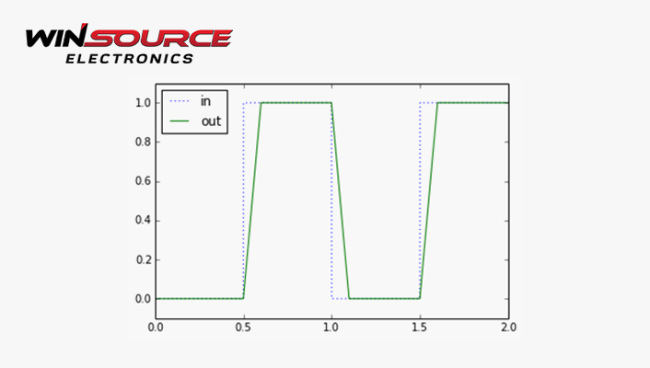
Knowing the slew rate is crucial for engineers and technicians working with electronic circuits. It is especially important in applications requiring rapid response to signal changes without distortion. It ensures optimal electronic system performance, accuracy, and reliability in various industries.
How do you define the slew rate?
Slew rate refers to the rate of change of an output voltage in response to a step change in the input signal in an electronic circuit. It measures how quickly a system’s output can change due to a sudden change in the input signal.
In simpler terms, imagine you have an electronic device like an amplifier. When the input signal suddenly changes from one voltage level to another, the amplifier’s output takes some time to switch from its initial voltage level to the new one. The speed at which this transition happens is known as the slew rate.
This rate is usually measured in volts per unit of time, commonly expressed as volts per microsecond (V/µs) or nanosecond (V/ns). A high slew rate means the output can change voltage quickly in response to input changes, while a lower slew rate indicates a slower response.
A high slew rate is crucial in applications where the circuit needs to accurately and quickly follow rapid changes in the input signal without introducing distortion or delay. For example, a high slew rate in audio amplifiers is essential to changing waveforms and preserving the sound’s fidelity.
What is an example of a slew rate?
An operational amplifier (op-amp) used in audio applications is an example of a slew rate. Imagine an op-amp configured as a voltage follower (buffer) replicating a sine wave input signal.
If the input signal suddenly changes from zero to one volt, the op-amp output should ideally follow this change instantaneously. However, due to the limitations of real-world electronics, the op-amp will take some time to transition from the zero-volt output to the one-volt output.
The slew rate, measured in volts per microsecond (V/μs), quantifies this transition. For instance, if the op-amp has a slew rate of 5 V/μs, it can change its output voltage by 5 volts in one microsecond.
So, with a high slew rate, the op-amp can swiftly transition from the zero-volt output to the one-volt output quickly, ensuring that the output waveform tracks the input waveform accurately without distortion or lag.
Critical of measuring using the Slew rate
Measuring slew rate, the speed at which a system responds to rapid changes in an input signal, is crucial in various electronic applications due to its impact on system performance, accuracy, and reliability.
Ensuring Signal Fidelity and System Stability
- Signal Fidelity: Maintaining signal fidelity is critical in systems handling high-frequency signals, such as amplifiers in audio equipment or data communication systems. Slew rate measurements ensure these systems can accurately reproduce fast-changing input signals without distortion.
- System Stability: High slew rates are essential for maintaining stability in control systems. For instance, in feedback control systems, slow slew rates can lead to overshooting or oscillations, destabilizing the system. Measuring and adjusting the slew rate helps in optimizing the system’s stability.
Amplifier and Op-Amp Design
- Amplifier Performance: Slew rate directly affects the performance of amplifiers, particularly operational amplifiers (op-amps). Faster slew rates in op-amps allow them to track input signals accurately, ensuring proper voltage response without introducing distortions or delays.
- Audio Quality: The slew rate of audio amplifiers impacts sound quality. A higher slew rate ensures that the amplifier can accurately reproduce rapid changes in sound signals, preventing distortion that may affect the perceived audio quality.
Limitation Identification and Component Evaluation
- Identifying System Limitations: Slew rate measurements help identify system limitations, guiding engineers to optimize circuit designs. If the measured slew rate is insufficient for the required application, it indicates the need for design modifications or using components with higher slew rates.
- Component Evaluation: Manufacturers often specify the slew rate in component datasheets. Engineers use these values to select components suitable for specific applications. Accurate measurements validate datasheet specifications and aid in selecting appropriate components.
Quality Assurance and Troubleshooting
- Quality Assurance: Slew rate testing is part of quality control processes during manufacturing. Ensuring that components meet specified slew rates guarantees that they function within the required performance parameters.
- Troubleshooting: Slew rate measurements can diagnose issues in circuits or systems. For example, if a signal appears distorted or delayed, measuring the slew rate can help identify if the problem stems from inadequate response time.
Future Advancements and Innovation
- Research and Development: Measurement and analysis of slew rates are critical in advancing electronics. Research into higher slew rate technologies enables the development of faster and more efficient electronic components, pushing the boundaries of technological innovation.
- Technology Evolution: As demands for faster, more accurate, and more efficient electronic systems increase, advancements in slew rate measurements drive technological evolution, leading to the creation of more sophisticated and reliable electronic devices and systems.
What is CMRR and slew rate?
MRR measures a device’s ability to reject unwanted signals that appear equally on both input terminals (the common-mode signal). It shows how effectively a device can suppress or ignore signs common to both inputs. A higher CMRR indicates better rejection of these unwanted common-mode signals. It’s crucial in amplifiers and differential signal processing circuits to ensure that only the desired signal is amplified or processed. Slew rate, on the other hand, measures how quickly an amplifier or circuit can respond to changes in the input signal. It indicates the output voltage change rate in response to a sudden change in the input signal.
Measuring slew rate allows you to assess how quickly the amplifier or circuit responds to changes in the input signal, indicating its speed and ability to track rapid signal variations accurately.
WIN SOURCE impresses with its extensive electronic components, featuring popular hard-to-find items for a proper slew rate. Their user-friendly website and precise categorization streamline searches for integrated circuits, discrete semiconductor products, and more.

COMMENTS